Salt intrusion
Salinity of water systems is the phenomenon where fresh water is (increasingly) salified. In many cases, fresh water must stay fresh for a number of reasons, such as the fresh water supply, use in agrigulture, industry, or nature.
|
Thema |
Zoetwatervoorziening, Delta facts, English versions |
|
Tags |
|
|
Downloads |
- INTRODUCTION
- RELATED TOPICS AND DELTA FACTS
- TECHNICAL SPECIFICATIONS
- GOVERNANCE
- COSTS AND BENEFITS
- CURRENTLY ACTIVE RESEARCH PROJECTS
- KNOWLEDGE GAPS
Introduction
Salinity of water systems is the phenomenon where fresh water is (increasingly) salified. In many cases, fresh water must stay fresh for a number of reasons, such as the fresh water supply, use in agrigulture, industry, or nature. The salinity process depends on different factors and can occur both via ground and surface water, resulting in internal and external salinity, respectively. This fact sheet does not address internal salinity via groundwater. Salinity of the surface water in deltas in the Netherlands and other European countries is becoming a growing problem, not least because of the effects of climate change (lower river discharges during dry summers, sea level rise) and growing demand for fresh water.
Related topics and Delta Facts
Topics: water shortage, fresh water supply, drought damage, salt damage, salinity, climate scenarios, fresh-salt water
Delta facts: Pricing of water for agriculture, Salt-tolerant crops, Brackish seepage, Rainwater lenses, Fresh water supply.
Technical specifications
Process
Salinity is the process of (increasing) salification of rivers and fresh inland waters. Salinity is perceived as a problem when these bodies of water must remain fresh(er) for certain purposes, often for extraction for drinking and industrial water and for supply to agricultural areas. But salinity can also be perceived as a problem for certain types of natural environments.
Intrusion of salt in typically fresh water in coastal areas is a natural process and in estuaries, it creates a unique habitat for organisms that can survive in both fresh water and brackish to saline environments. An estuary is a transition zone where fresh water from a river meets the salt water from the sea. A gradual transition from fresh to salt water creates the most attractive condition for many types of organisms because of the biodiversity of estuaries in general. In fact, some salt water fish species reach their spawning grounds by migrating upstream from salt to fresh water in order to spawn.
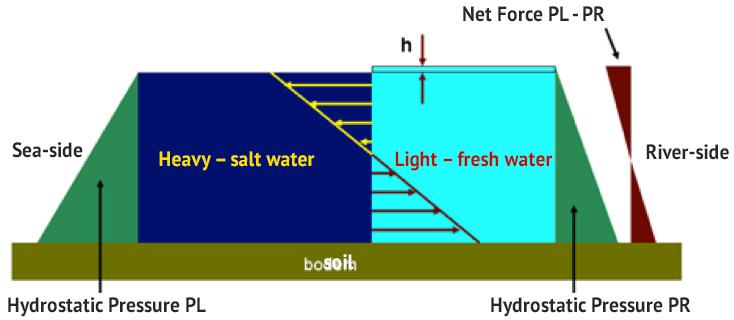
Figure 1. Water pressure (green triangle) in the heavier (salt) water on the left increases more rapidly than in the lighter (fresh) water on the right. For balance, a slight water level increase (h) on the right is necessary. The difference between the water pressures provides the pressure distribution (brown triangles), which drives the illustrated exchange flow (arrows) (Friocourt et al., 2012).

Figure 2. Propagation of the (red) salt wedge from the sea to the right across the soil. Not visible is the return flow of lighter river water to the left above the salt wedge (Friocourt et al., 2012).
Salt intrusion occurs when a volume of salt water is heavier than the same volume of fresh water. Seawater weighs on average 2 to 3% more than fresh water. In areas where both fresh and salt water are present, fresh water floats on top of the heavier salt water, which forms the so-called salt wedge. This salinity process is inhibited by the mixing of fresh and salt water and counter pressure from the fresh water inflow, gradually reducing the salinity upstream. The extent and development of salt intrusion depends on factors such as the amount of (fresh) water the river discharges, the shape of the estuary and the sea level. Because these factors can vary in terms of time and location, salt intrusion process may occur over a short distance, or very gradually over tens of kilometres.
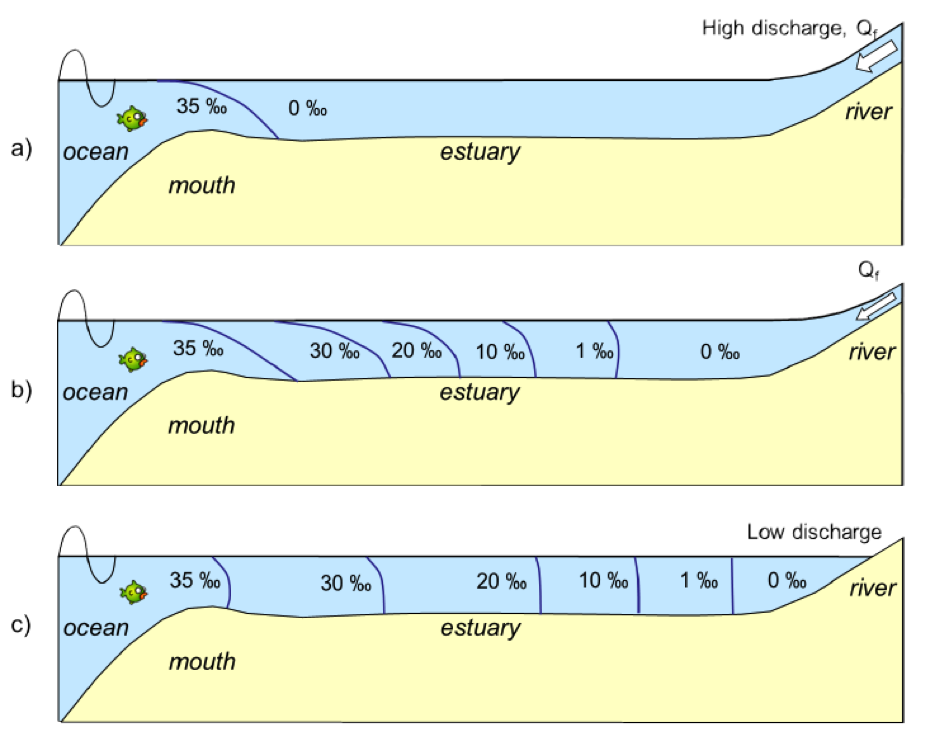
Figure 3. Cross section of salinity levels in a stratified estuary (a), a partially stratified estuary (b), and a well-mixed estuary (c) (Savenije, 2012).
Because of the unique situation in the Netherlands, where the western part of the country is actually a large estuary with large areas under water, salt intrusion is one of the natural processes that must be taken into account in (daily) water management in order to keep some areas artificially fresh.
In a river estuary, where the river opens out into the sea, the salt water can penetrate the estuary in a natural way. In the case of the Rhine-Meuse estuary, under normal conditions the salt intrusion stops under Rotterdam, but the degree of salt intrusion varies depending on the tidal cycle (spring/neap tide), river discharge (the lower the river discharge, the further inland the salt enters), and sea water levels due to wind direction and intensity.
In dammed rivers, the dam creates an impenetrable barrier, although salt can penetrate the river through seepage under the dam. This can be seen as a form of internal salinity (which is not the object of this fact sheet). Salt water can penetrate the dammed river (e.g. Closure Dike, North Sea Canal) only if there are facilities in place to allow the passage of ships (sluice gates) and fish ladders.
The problem
In the Netherlands, (fresh) river water serves many uses. It is one of the major sources of water for drinking, agricultural and industrial needs. To ensure these functions, the water must have very low concentrations of sodium and chloride. Sodium chloride is a salt that occurs naturally in almost all waters, including seawater. Drinking water with elevated concentrations of sodium chloride can affect the taste of water and cause adverse health effects in humans and animals over time. Agricultural crops have little tolerance for elevated salt concentrations in irrigation water and in soil water in the root zone. The extent of tolerance depends on the crop, the variety and the growth stage at which elevated salt concentrations occur in the root zone. The presence of unwanted minerals in process water for industrial use may result in additional costs for treating the water to meet standards for appropriate use, or in additional maintenance costs due to increased corrosion.
There are various water intake points located across the Netherlands, including the estuary in the western part of the country, where in most circumstances, the salt water does not reach and mix with the fresh water in these locations. Users obviously want to prevent possible blockage of the intake points as much as possible. However, because the inland penetration of salt water depends on fluctuations in natural conditions, occasional salinity of the intake points unfortunately cannot be avoided. Salt intrusion can lead to problems, especially during sustained periods of low river discharge (a few weeks or even longer). The droughts in 1976 and 2003 are prime examples of the devastating impact of salt intrusion.
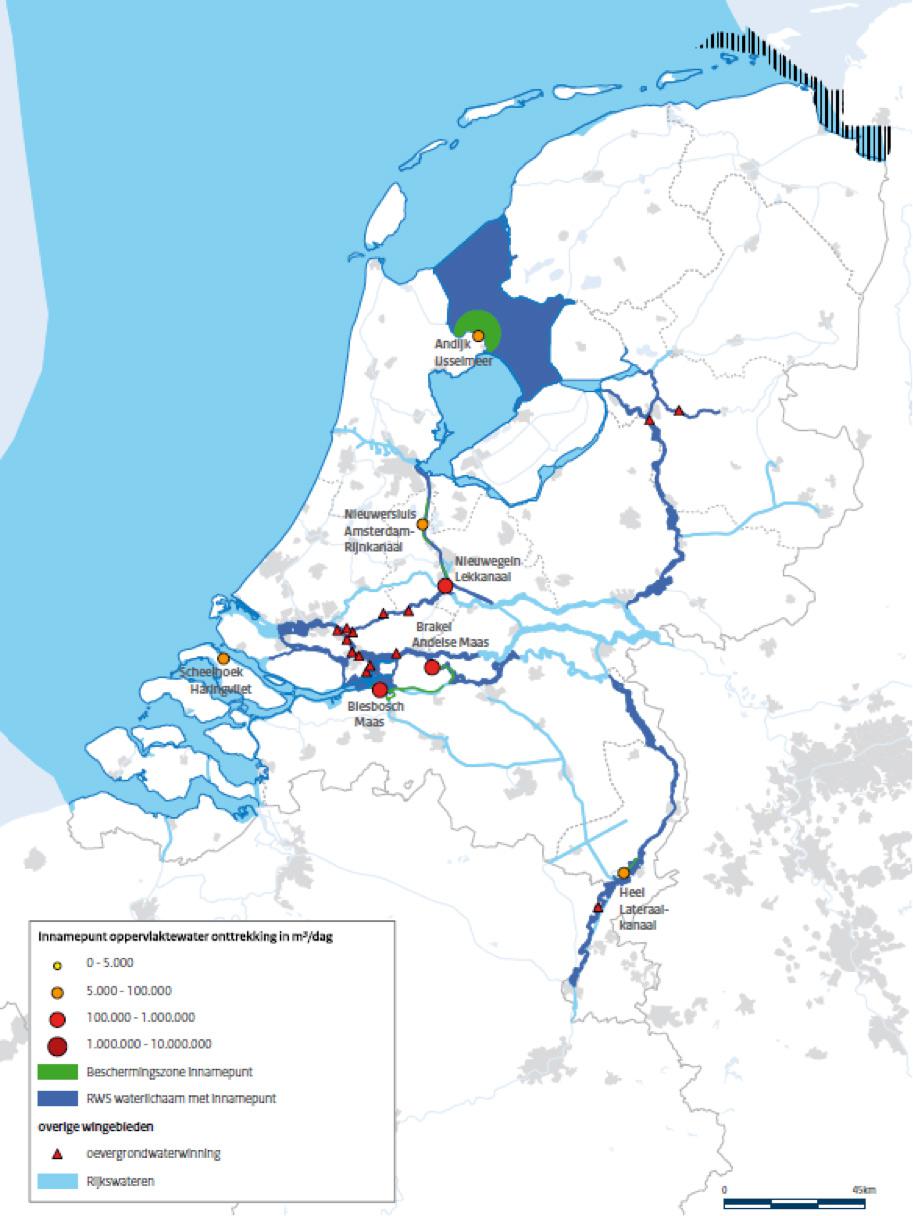
Figure 4. Overview of drinking water intake points in surface waters in the Netherlands (Ministry of Infrastructure and the Environment, 2012).
The solutions and measures
The salt intrusion process can be influenced and controlled through various measures that will help keep the fresh water supply up to standard for as long as possible, and thus reduce potential water shortages for the different users.
Measures to influence the extent of salt intrusion:
| Type of measure | Effect | Example | Execution |
| Shift salt boundary to sea as much as possible | Artificial control of fresh water discharge to the river estuary where most salt water penetrates, or where most fresh water is required. | Haringvliet locks | The lock’s dynamics are controlled by the intensity of the river discharge. During periods of low river discharge, the Haringvliet locks close, allowing the fresh river water to flow through the Nieuwe Waterweg and create maximum counter pressure to the inflow of fresh water |
| Cause additional mixing | This enhances the natural mixing process between fresh and salt water, reducing the inland transport of salt water. | Bubble plumes in the Nieuwe Waterweg | Compressed air is injected from the bottom of the estuary, creating air bubbles that move upwards and vertically displace and mix the salt and fresh water. |
| Human modification of the river mouth | Modified depth and width, or a controllable opening to reduce the volume of salt water during high tide and increase the inhibitory potential of the fresh water. | Salt stair, in the Nieuwe Waterweg, the Scheur and the Nieuwe Maas | The bottom of the river estuary is dredged up to create a staircase profile (with stairs ascending inland), reducing the tidal volume, and thus the possible penetration of salt water. |
| Balance Island(winner of the Delta Alliance Young Professional Award 2011-2012) | A partially explored idea to situate artificial islands at the mouth of Haringvliet to further slow the tide and reduce the salt intrusion. | ||
| Measures at locks | Reduce/prevent salt leaks through locks | Air bubble screen (Terneuzen sea lock, Krammerjachten lock as part of the pilot) | Create a screen of air bubbles by injecting compressed air into the bottom of the lock to partially separate salt and fresh water. |
| Water screen (Krammerjachten lock as part of the pilot) | To strengthen the air bubble screen, (fresh) water is injected in front of the bubble screen at the bottom of the lock to further reinforce the separating effect of the bubble screen. | ||
| Eblekkende lock gate (Krammerjachten lock as part of the pilot) | Design the lock gate to allow fresh water into the salt water basin in order to drive the salt water further out. | ||
| Salt trap (Terneuzen sea lock, Krammerjachten lock as part of the pilot) | Excavate a ditch in the fresh water basin to trap the (heavier) salt water that leaks through the locks. A pump recirculates the salt water back to the salt water basin. | ||
| Fresh/salt water separation system (Krammer locks, formerly the Kreekrak locks) | The design of these locks is premised on the fact that salt water has a higher density than fresh water (1.03 kg/dm3 compared to 1.00 kg/dm3). When fresh and salt water are mixed, the salt water sinks to the bottom. Suppose: a vessel sailing from Oosterschelde enters the lock. The gates close behind it. The salt water is then pumped out from the bottom of the lock, and fresh water is pumped in from the top. When the water level has dropped sufficiently and the salt water is pumped out, the lock opens. When a vessel passes from the Volkerak into the Oosterschelde, an almost similar process occurs, but in reverse order: the gates close behind the vessel as it enters the lock. Most of the fresh water at the top is pumped out, while salt water is pumped in from the bottom. When the water level rises to the level of the water in the Oosterschelde, the lock gates in front of the ship open. |
Table 1. Overview of measures to influence the degree of salt intrusion.
Measures to supply fresh water to users when and where they need it, or to improve the quality of the river water:
| Type of measure | Effect | Example | Execution |
| Water quality agreements with other countries | Discharge and chloride concentration agreements with Germany and France, for example. | Salt treaty | The Netherlands has entered into agreements with so-called Rhine countries for improving the quality of the Rhine by reducing the duration and frequency of discharge containing high salt concentrations in the Rhine. A measure in this regard is that the French potash mines temporarily hold back the salt during periods of low river discharge. |
| SWS (Small-scale Water Supply) | In the event of salinity of the Hollandsche IJssel, fresh water will be supplied from elsewhere. | Hollandsche IJssel | During (very) low river discharges and (very) high chloride concentrations at the mouth of the Hollandsche IJssel, water intake is stopped at this point. Water to the regional water system (Stichtse Rijnlanden, Schieland & Krimpenerwaard, Rijnland and Delfland water boards) is then supplied from the Amsterdam-Rhine Canal. |
| Amsterdam-Rhine Canal and North Sea Canal discharge | Reduce salt intrusion from the North Sea Canal by discharging additional water from the Amsterdam-Rhine Canal. | Amsterdam-Rhine Canal | Salt leaks at the IJmuiden sea locks lead to salt intrusion in the North Sea Canal. This creates risks for the water intake point at the Nieuwer lock. To prevent the salt water from entering deep into the Amsterdam-Rhine Canal, fresh water is continuously discharged from the Waal via the Amsterdam-Rhine Canal. |
Table 2. Overview of measures to supply fresh water to users when and where they need it, or to improve the quality of the river water.
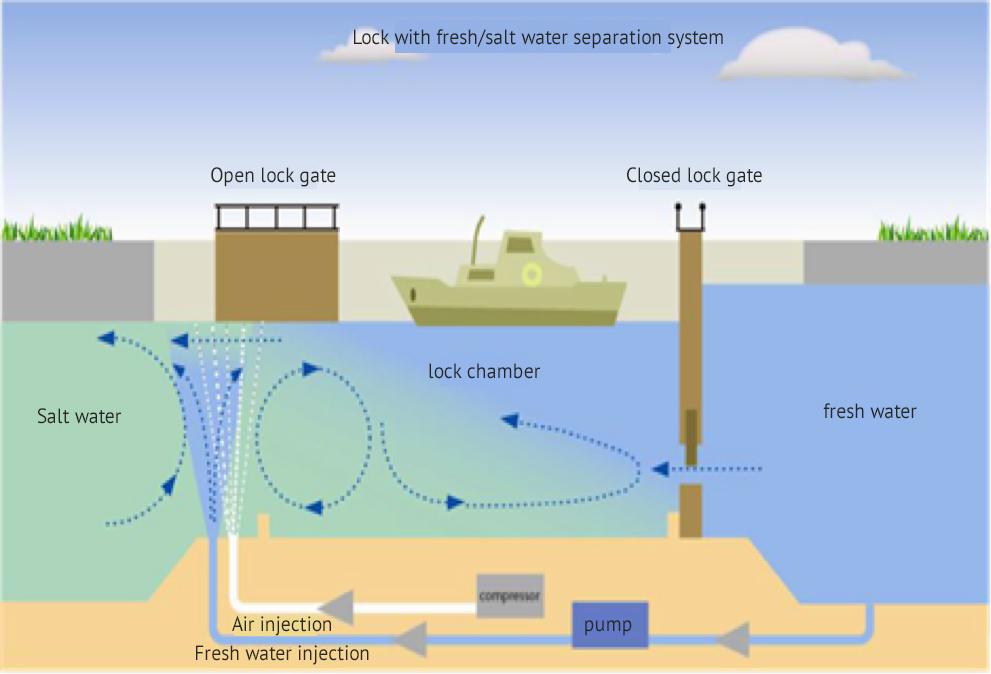
Figure 5. Lock with innovative fresh-salt water separation system (Villars et al., 2011) with:
- an air bubble sheet consisting of a row of diffusers (‘shower nozzles’), each mounted above one or multiple pneumatic valves, always ensure even air distribution across the lock width. A double row, fitted with staggered diffusers, is used to make the air bubble sheet, and especially the toe, as impermeable to salt as possible;
- a water screen consisting of a tube or sleeve with a narrow slot through which water is injected. The water coming from the port or a salt trap may optionally be released in free-fall or pumped to the salt water side of the lock chamber;
- an elevated threshold to reduce the effective water depth of a lock and thus the salt leakage;
- ebb gates where the paddles in the closed lock gate stand ajar, allowing the (fresh) water to leak in through the lock gate and create a fresh water flow through the lock in order to displace or push back the saltier water;
- a salt trap, i.e. a deep well or trench on the fresh water side outside the lock. The salt(ier) water flowing through the lock sinks into this well or trench as a result of its higher density and is collected therein. The salt(ier) water is therefore temporarily stored until the well or trench overflows or until the water is pumped back to the salt water side of the lock.
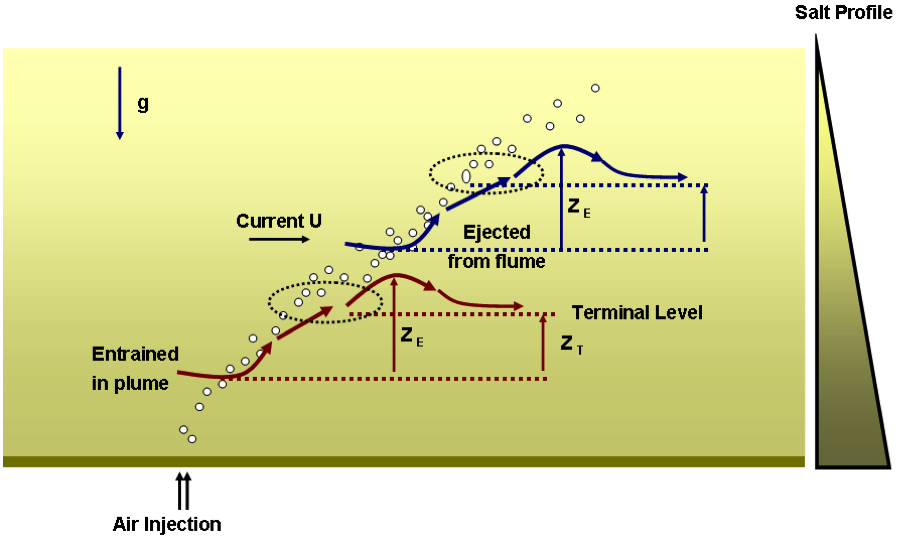
Figure 6. Effect of a bubble plume in water flow to enhance mixing. Water flows mainly through the plume and gets an upward boost from the force of the air bubbles. Water exiting the plume from the lee side has the vertical speed it received in the plume from the upward boost and follows an upward sloping track. Because of the increasing weight of the ejected water and its turbulent exchange of momentum with surrounding water, the ejected water reaches maximum height difference ZE with respect to its entrance height. At ejection height ZE, the ejected water is heavier than the surrounding water and falls back to terminal height ZT, which is higher than on entry into the plume. After all, during travel to ejection height and back to terminal height ZT, the ejected water travels at a different speed than the surrounding water. This creates turbulence and mixing, which slows down and makes the ejected water lighter than it was on entry into the plume. It also causes the salt and fresh water to mix (Friocourt e.a. 2013).
Governance
The Ministry of Infrastructure and the Environment is responsible for the main water system (large water bodies, like the sea and rivers), while the water boards are responsible for the regional water systems in their management area, which by and large are smaller water bodies such as canals and polder canals.
Water agreements between the Ministry of Infrastructure and the Environment and water boards include agreements on the exchange of quality and quantity of water under normal circumstances. In the event of (imminent) water shortage, the national priority list applies. The priority list determines how the available water is distributed in the main water system during periods of water shortage. The priority list consists of four categories, where category 1 has the highest priority and category 4 the lowest. According to the priority list, the drinking water supplies are so large that they do not fall into the first category. See figure Rural Priority List of the National Coordination Committee on Water Distribution in the Fresh Water Supply Delta Fact.
Costs and benefits
Economic damage sustained by water users due to water shortage cannot always be properly identified. Costs of measures, such as construction and maintenance, are easier to determine. In some measures (air bubble plumes, air bubble sheets), the energy costs represent a significant portion of the cost items.
Field experience and currently active research
Salt Stair
Research is currently underway into the effectiveness and costs of restoration of the Salt Stair in the Rhine-Meuse estuary. The measure was built in the 70s, but proved ineffective due to improper maintenance (Kuijper & van der Kaaij, 2009; van der Kaaij et al., 2010).
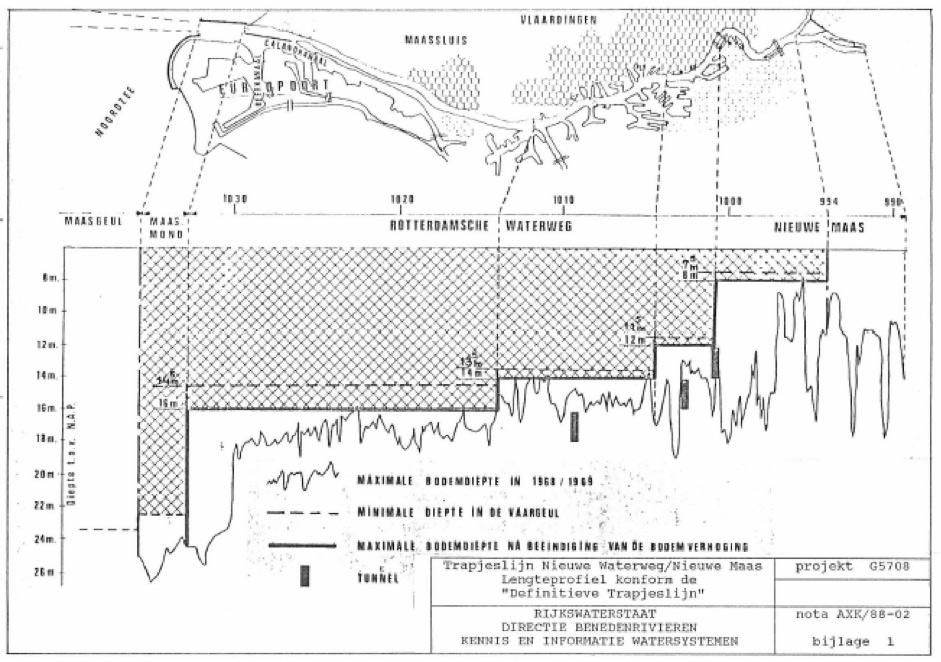
Figure 7. Salt Stair around the time of construction (Ministry of Infrastructure and the Environment, 1988)
Bubble plumes
Research into the performance and effectiveness of air bubble plumes to enhance the mixing of water in the Rhine-Meuse estuary with the aim of shortening the length of the transition zone between salt and fresh water (Friocourt et al., 2012, 2013).
Innovative fresh/salt water separation system in locks
Research into the performance and effectiveness of innovative fresh-salt water separation systems for locks as part of various projects, resulting, for example, in the design of a newer, more effective type of air bubble screen (Villars et al., 2011). A numerical model was additionally developed to quantify the level of salt leakage through locks both with and without various measures. This has led to the pilot 'Innovative fresh-salt water separation system for the Krammerjachten locks’ (see below). Deltares is also participating in several research projects for the development of new locks (e.g. in IJmuiden).
Innovative fresh-salt water separation system in Krammer locks
The Krammer locks are built with a unique system that separates salt and fresh water. The current fresh/salt water separation system in the Krammer locks has been in operation since the closure of the Volkerak-Zoom lake in 1987, and is based on the principle that the lock chambers are almost completely filled with fresh water when vessels transfer from the Oosterschelde to the Volkerak-Zoom lake by lock. When lock transfer occurs from the opposite direction, the chamber is largely filled with salt water. This measure was designed to prevent too much salt water from the Oosterschelde flowing into the fresh water Volkerak lake, and too much fresh water from Volkerak flowing into the Oosterschelde during the passage of vessels. While very effective, the system also happens to be very expensive in terms of management and maintenance, and time-consuming for the shipping industry. A decision must be taken in 2014 on the overhaul of the current fresh-salt water separation system. Because the system is due for renovation, salt leakage occurs as ships pass through the locks: salt water leaks into the fresh water of the Volkerak-Zoom lake. If this continues for too long, the water will no longer be usable for drinking or agriculture. Renovation of the locks with the current system (where water in the lock chamber is completely replaced by the desired type of water) is costly. In addition, it takes a long time for vessels to pass through the locks. Thus, the Ministry of Infrastructure and the Environment has commissioned earlier studies to determine whether salt leakage could be reduced by way of other measures.
A number of innovative measures (air bubble sheet, water sheet) have been extensively tested in the Deltares laboratory and in the Stevin lock (Closure Dike). Because this has been successful, the question now is whether the current fresh-salt water separation system can be replaced by the innovative fresh-salt water separation technologies. The innovative fresh-salt separation system is in all probability as effective as the current system, but more cost-effective in terms of management and maintenance, and also less time-consuming for the shipping industry due to more efficient lockage. The Innovative fresh-salt water separation system pilot is set to kick off in the recreation season of 2014 in one of the two Yacht locks before the maintenance decision is taken in the autumn of 2014. The new salt leak-reduction measures will be compared and contrasted with the current system for efficiency, performance and cost-effectiveness. This pilot is commissioned by the Ministry of Infrastructure and the Environment in collaboration with Royal HaskoningDHV Nederland BV (RHDHV) and Deltares. The pilot in the Yacht lock in the Krammer locks will be completed in late August 2014, when a decision will be made as to whether this system will also be built in the other Krammer locks.
Management of intake points for fresh water supply
Research into the robustness of the current management of some water intake points (with respect to the Brielsemeer, for example) in order to limit or reduce congestion times during periods of low river discharge (Evides, 2014; De Vries, 2014).
Delta Fresh Water Programme
The Delta Programme aims to develop a long-term strategy for water management and a spatial planning policy where sustainable social development is resilient to the inevitable impacts of a changing climate. This, however, raises the question as to which guiding decisions need to be made now in terms of the water management and the spatial planning policy of our country – so-called delta decisions - and which decisions could or should be deferred to the future.
In this context, the projected long-term consequences for the water system and for the use functions are calculated for different combinations of scenarios and measures. In the Delta Programme the measures in both the main water system and in the regional water system will be assessed for their effectiveness. An attempt will also be made to identify the financial loss resulting from salt intrusion in order to quantify the costs and benefits of measures (ter Maat et al., 2014).
Research into the impact of fish corridors on salt intrusion
Construction of dams and hydraulic structures has all but made the fresh-salt water transitions in the Netherlands disappear. Natural fresh-salt water transitions serve as fish corridors for seasonally migrating species such as salmon and sea trout, which spawn in fresh water environments. Since the ‘90s, restoration of saline and brackish coastal waters in the Netherlands has become increasingly important. Restoration of the fresh/salt water transitions improves the water quality in the Netherlands and maintains and enhances biodiversity. Earlier research, for example, examined different ways of leaving the Haringvliet locks ajar without compromising the fresh water supply. Research projects are currently underway to establish the feasibility of a fish migration river in the Closure Dike (Programme to a Rich Wadden Sea, 2013)
Knowledge gaps
While the processes involved in salt/fresh water exchange in estuaries and locks are generally well known, their interaction in specific locations (e.g. the exchange of salt/fresh water between river outflow and longshore current flows as a function of the tide, or the interaction between the passage of ships and density current flows at locks) is not.
In the monitoring network of the Ministry of Infrastructure and the Environment salinity and other water quality parameters are continuously measured to prepare for salinity events. The Ministry of Infrastructure and the Environment examines how its measurement strategy can be enhanced in order to better identify the leading processes and make modelling of salt intrusion (even) more reliable (Schroevers et al., 2014).
Determining the supply levels will require knowledge of the statistics of salinity events in the main water system and how this translates into shortages in the regional water system and at local and user level.
Climate studies indicate that periods of low river discharge will occur more frequently in the future. In this context, measures currently in use are studied to determine whether they will meet future needs or whether new measures are required. Much of this research is carried out as part of the Delta Fresh Water Programme. The Delta Programme is a national programme commissioned by the national government, provincial and municipal governments and water boards.
While some measures will need to be maintained, some of the old measures will be assessed for effectiveness and, where necessary, more appropriate (i.e. more effective or cost-effective) measures will be sought. This, for example, is the case for the Krammer locks.
Lastly, past measures should continuously be assessed against current and future socio-economic developments, e.g. improving port accessibility by widening/deepening waterways, or building larger locks, improving ecological conditions of river estuaries, all of which could affect the salinity problem and how it is addressed.
Proper assessment and consideration of various measures rely on answers to knowledge questions about identifying the benefits of salinity control, in particular in the area of agriculture and aquatic and terrestrial nature.

 English resume
English resume